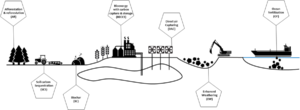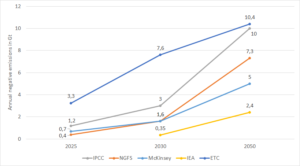Preference profile
Elaboration of your requirements for CDR projects, taking into account your climate strategy, planning horizon and stakeholders.
You want to use CDR solutions to neutralise residual emissions or to maximise the climate impact of your resources. We support you in the development of your tailor-made CDR portfolio and accompany the implementation, among others by:
Your contact
Simon Göß
What is Carbon Dioxde Removal?
Carbon Removal, also Carbon Dioxide Removal (CDR), is the process of capturing CO2 from the atmosphere and trapping it in carbon sinks. Some techniques are already being used on a small scale, while others are still in the early stages of development.
Many different natural and technological solutions for taking greenhouse gases out of the atmosphere exist. Those negative emission technologies differ in terms of the final reservoirs of CO2, the durability of storage outside the atmosphere, their cost structure, and their environmental and socio-economic side effects.

What is a CDR portfolio?
A CDR portfolio consists of certificates from different CDR projects. Through this diversification, a CDR portfolio can reduce price and default risks and thus ensures a low-risk implementation of a corporate climate and carbon removal strategy.
Why should your company use CDR certificates or projects?
For credible climate targets and to avoid greenwashing accusations, certificates from high-quality CDR or compensation projects are preferable to other offsets. Ambitious climate strategies and standards, such as the Science Based Targets Initiative (SBTi), call for the neutralisation of emissions and thus the use of CDR certificates or projects.
How can I be sure that the selected projects actually remove greenhouse gases from the atmosphere?
In order to generate CDR certificates, projects must follow certain technicall standards. The compliance of CDR certificate providers with these standards is verified by external service providers and platforms.
carboneer works with high-quality CDR projects and marketplaces. Independent verifiers ensure that CDR certificates are only issued for greenhouse gases actually removed from the atmosphere. Avoiding double counting of CDR certificates is ensured by the terms of use at the marketplaces and the project verifications.
What are the prices for a CDR certificate?
The prices for CDR certificates vary greatly depending on the technology and can range from 30 to more than 500 EUR/tonne. In general, the higher the price, the more long-term and climate-effective the removal of CO2 from the atmosphere.
What does offsetting mean?
Offsetting refers to the balancing of corporate CO2 emissions through the purchase of CO2 credits on voluntary emissions markets or from project developers. The CO2 credits can come from offset or neutralisation projects.
What is the difference between compensation and neutralisation?
A compensation project avoids the emission of CO2 compared to a baseline scenario. The project can issue a corresponding number of compensation certificates. The definition of the baseline scenario and the corresponding climate impact of the project are often difficult to determine.
In contrast, projects that remove CO2 or other greenhouse gases from the atmosphere can generate CDR certificates. The use of these CDR certificates to offset corporate greenhouse gas emissions is known as neutralisation.
What is a carbon credit?
A carbon credit represents the certified reduction of one tonne of carbon dioxide equivalent or the removal of one tonne of carbon dioxide equivalent (tCO2e) from the atmosphere.
What are the requirements for carbon credits?
Different organizations (e.g. Puro, Gold Standard, Verra) define different strict quality criteria for carbon credits.Generally, offset and neutralisation projects must:
– Meet and follow international standards (Certification)
– Demonstrate credible and verifiable emission reductions or removals of greenhouse gases from the atmosphere (Real Projects)
– Certification and verification of data must be carried out by independent third parties (Independent Verification)
– The emission reduction or removal of greenhouse gases from the atmosphere must not have occurred without the project activity (Additionality)
– Each compensation or CDR certificate may only be cancelled once (no double counting)
– All project impacts must be transparent and recorded in a public register (Traceability)
How many tonnes of greenhouse gases must be removed from the atmosphere to achieve global climate targets?
The magnitude of the necessary removals is expected to range between 4.5 and 15 gigatonnes of CO2 per year from 2030 until the end of the century. This corresponds to about 15 to 50 per cent of today’s annual global anthropogenic CO2 emissions. The order of magnitude depends on the rate of greenhouse gas conservation and reduction in all sectors.
